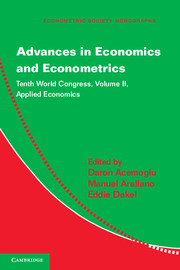Book contents
- Frontmatter
- Contents
- Contributors
- Preface
- I FINANCE
- II POLITICAL ECONOMY
- III MACROECONOMICS
- 5 Job Search, Labor-Force Participation, and Wage Rigidities
- 6 From Wages to Welfare: Decomposing Gains and Losses from Rising Inequality
- IV TRADE AND FIRM DYNAMICS
- V GROWTH
- VI FRISCH LECTURE
- VII PERSPECTIVES ON CHINESE ECONOMIC GROWTH
- Name Index
- Miscellaneous Endmatter
6 - From Wages to Welfare: Decomposing Gains and Losses from Rising Inequality
Published online by Cambridge University Press: 05 May 2013
- Frontmatter
- Contents
- Contributors
- Preface
- I FINANCE
- II POLITICAL ECONOMY
- III MACROECONOMICS
- 5 Job Search, Labor-Force Participation, and Wage Rigidities
- 6 From Wages to Welfare: Decomposing Gains and Losses from Rising Inequality
- IV TRADE AND FIRM DYNAMICS
- V GROWTH
- VI FRISCH LECTURE
- VII PERSPECTIVES ON CHINESE ECONOMIC GROWTH
- Name Index
- Miscellaneous Endmatter
Summary
Introduction
The structure of relative wages in the U.S. economy has undergone a major transformation in the last 30 years. Wage differentials between more- and less-educated workers have risen sharply (Katz and Autor 1999; Lemieux 2008). Within narrow groups of workers defined by education, gender, and birth cohort, the distribution of wages has become much more dispersed (Juhn, Murphy, and Pierce 1993). This increase in within-group dispersion reflects wider fixed individual wage differentials and more pronounced volatility in both persistent and transitory shocks (Gottschalk and Moffitt 1994, 2009). Overall, the U.S. wage structure has become much more unequal.
This surge in U.S. economic inequality has generated great interest among labor economists and macroeconomists. A vast theoretical and empirical literature investigates the sources of the phenomenon. The leading explanation is that the widespread adoption of new information and communication technologies has raised the relative productivity of more-skilled labor – complementary to the new technologies in production – and lowered the demand for less-skilled workers employed in tasks easily replaceable by the new machines (Krusell, Ohanian, Ríos-Rull, and Violante 2000; Acemoglu 2002; Autor, Katz, and Kearney 2006; Acemoglu and Autor 2010). A less-prominent role is attributed to falling demand for unskilled-intensive goods produced in the United States because of greater openness to trade and offshoring of unskilled stages of production (Feenstra and Hanson 1996; Burstein and Vogel 2010). The rise in idiosyncratic volatility is viewed as the result of a more turbulent work environment and faster skill obsolescence (Violante 2002); changes in wage-compressing labor-market institutions such as unions (DiNardo, Fortin, and Lemieux 1996); and a contractual shift toward performance-based and piece-rate pay (Lemieux, MacLeod, and Parent 2009).
- Type
- Chapter
- Information
- Advances in Economics and EconometricsTenth World Congress, pp. 235 - 280Publisher: Cambridge University PressPrint publication year: 2013
- 7
- Cited by

